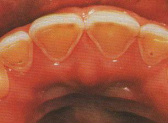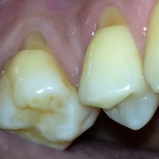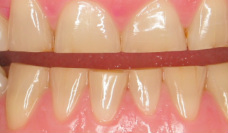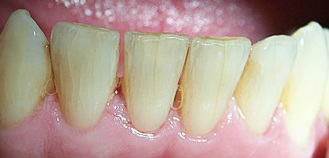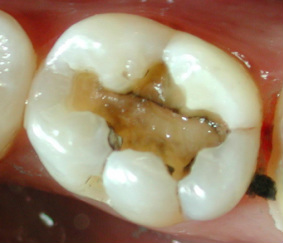Abrasions and Cracks in Teeth
Aside from dental caries (tooth decay) there are a number of processes which cause damage to tooth structure over the lifespan of a tooth. They are Erosion, Abrasion, Abfraction, Attrition and Cracks.
Because of these processes it is possible for a person who has NO dental caries to suffer damage to the teeth that may necessitate restorations or in extreme situations even extraction and replacement.
Because of these processes it is possible for a person who has NO dental caries to suffer damage to the teeth that may necessitate restorations or in extreme situations even extraction and replacement.
|
Erosion
is defined as the wearing down of tooth substance by chemical processes. Our teeth are essentially Calcium Carbonate and anything acidic (and our food and drinks are practically all have some form of acid in them) will react with the enamel surface, softening it, roughening it or even removing a layer. Erosion usually leaves the entire affected surface evenly "worn down" unless some other factor (Attrition/abrasion/Caries) comes into play. |
Managing Abrasion and Erosion
The most important aspect of managing abrasion and erosion of teeth is to eliminate or reduce the root cause. This means, for example, changing your toothbrush, modifying your diet or lifestyle.
Once the causative factors have been addressed, the lesions caused by the abrasion/erosion need to be assessed and restored if required. If restoration is required it usually takes the form of bonded direct restorations (fillings). Occasionally the damage may be so extensive that crowns and/or root canal therapy is needed.
Once the causative factors have been addressed, the lesions caused by the abrasion/erosion need to be assessed and restored if required. If restoration is required it usually takes the form of bonded direct restorations (fillings). Occasionally the damage may be so extensive that crowns and/or root canal therapy is needed.
|
Abfraction
Our teeth flex somewhat every time we chew from side to side (which is the normal way of chewing). If this flexing strain is high, over time it is possible that part of the tooth may chip off. Typically this occurs at the neck of the tooth, at the demarcation between the enamel and the root as this is the region subjected to the highest flexing stress. Abfractions generally leave relatively deep angular defects classically at the gum line of teeth. |
|
Attrition
is defined as the wearing down of teeth due to contact with other teeth. By definition attrition is seen only on the biting surfaces of teeth. It is a perfectly normal and practically unavoidable process because we use our teeth all the time for chewing and we clench our teeth frequently every single day. |
Management of Abfraction and Attrition
Abfraction and Attrition are only symptoms of an underlying problem with excessive bite force or grinding of the teeth either during daily activities (for example if a bodybuilder who repeatedly clenches during weight training) or more frequently night grinding/clenching.
The management of of bite load is based on the principle of placing something less hard than the teeth between the upper and lower teeth so that the softer object wears out in preference to the teeth. This is the principle behind most nightguards and sports guards (which in addition are also designed to protect against trauma)
The management of of bite load is based on the principle of placing something less hard than the teeth between the upper and lower teeth so that the softer object wears out in preference to the teeth. This is the principle behind most nightguards and sports guards (which in addition are also designed to protect against trauma)
|
Cracks in teeth
Cracks in teeth are a common phenomenon and this definition covers a very wide range of conditions. The commonest and most benign form of crack is craze lines restricted to the enamel. Enamel is like porcelain, hard but brittle. When subjected to repeated impact microcracks will start to develop in the structure of the enamel. Over time these cracks increase in size and join together. At this point they start to become visible as craze lines which usually run vertically through the enamel structure. Cracks due to trauma occur most commonly on the most prominent front tooth if it suffers trauma due to impact (typically from a fall or impact to the face). Such an injury can lead to outright fracture of the tooth but if it does not, a horizontal crack line may be visible in the enamel. Deeper cracks that extend in to the dentine layer are commonly seen in molar teeth especially in patients with a history of teeth grinding or heavy clenching or who have very strong chewing muscles (and hence heavy bite force). These cracks are usually visible but sometimes can be so fine that they cannot be detected. They can also occur underneath restorations so that they are not visible at all. |
Management of Cracks
There is no specific management for small cracks in teeth. In fact in many cases trying to place restorations to deal with craze lines or superficial cracks does more harm than good because either the restoration is so small that it is lost almost immediately or if the crack is enlarged to make the restoration more durable, the loss of tooth structure surrounding the crack is such as to cause a further weakening of the tooth.
Deep cracks however are a different matter. If a crack is at risk of affecting the nerve of the tooth or has already affected the nerve to some extent it is necessary to crown the tooth. A crown will provide the necessary coverage and protection to prevent the crack from extending further. Fillings do not provide this coverage. Of course if the nerve is affected a root canal therapy is needed and if the crack extends into the root structure, the tooth cannot even be restored and will need to be extracted.
In our experience this sometimes leads to slightly difficult conversations with patients because it seems that we either advise doing nothing at all and then, as the situation changes, advise crowning the tooth with seemingly nothing in between. From the preceding paragraphs it should be clear why this situation occurs.
Deep cracks however are a different matter. If a crack is at risk of affecting the nerve of the tooth or has already affected the nerve to some extent it is necessary to crown the tooth. A crown will provide the necessary coverage and protection to prevent the crack from extending further. Fillings do not provide this coverage. Of course if the nerve is affected a root canal therapy is needed and if the crack extends into the root structure, the tooth cannot even be restored and will need to be extracted.
In our experience this sometimes leads to slightly difficult conversations with patients because it seems that we either advise doing nothing at all and then, as the situation changes, advise crowning the tooth with seemingly nothing in between. From the preceding paragraphs it should be clear why this situation occurs.

